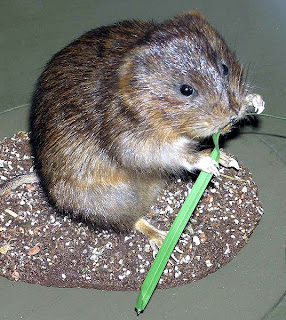As many people in the UK at least will know, Ratty in Wind in the Willows was actually a Water Vole, Arvicola terrestris (there is some dispute about the scientific name – it may be more properly described as A.amphibius). Once a familiar sight along canals and rivers, anywhere in Britain (including northern Scotland) where there is dense grass or reed next to water, the Water Vole has experienced a catastrophic drop in numbers in recent years. The main causes appear to be habitat destruction and even more the spread of American Mink, which have escaped or been released from fur farms (in some cases by animal rights activists). Unfortunately, Mink are far more successful predators of voles than native ones such as Otters, Barn owls and Grey Herons, and in fragmented habitats especially the voles cannot survive the predation pressure.
If mink control is in place however (using traps placed inside pipes on rafts, which mink use but other animals will not), and the habitat is reasonable intact, translocation and reintroduction of voles is quite possible. Another positive factor is the re-establishment of Otters – they appear to attack, or at least suppress the numbers, of Mink. Otters will themselves prey on Water Voles, but prefer other prey.
Although Bristol does not have voles on show at present, the zoo was involved in a highly successful introduction to a small stream running on to the Somerset Levels, which has resulted in a population expanding and beginning to recolonise increasingly large areas of its former range.
The interesting thing about the reintroduction area is that it is not one which would usually be considered for this sort of project – the stream is basically a ditch running along the back of a car storage park at Portbury Dock at the mouth of the River Severn. These so called ‘brownfield’ sites are an often overlooked area for wildlife – the operating assumption is that derelict industrial ground is abandoned by wildlife and has no conservation value. In fact, compared to monoculture farmland, especially if it is heavily supplied with fertilizers and pesticides, an industrial area can be a good place to find many creatures, especially localised invertebrates or rare plants. This is because the barren soil, often with a chemical composition different from the surrounding area, makes it a locality where such plants and animals have far less competition and their specialised adaptations are of use in the survival game.
The whole project covered two years of reintroductions, and on going monitoring and control of mink. The source animals were wild caught in various parts of the UK and bred in pens over the summer preceding the release year. Although unrelated groups of voles will fight viciously, adult pairs and their offspring will usually tolerate each other well. The voles were fed on rabbit food plus apples, carrots etc – the usual small rodent mix – and released from pens made of plastic storage boxed with the bottoms cut out. Dug in to the bank and weighted down, a few voles were placed in each and supplied with food, then left to dig their way out – this is the best way found of ensuring they have protection while they establish their burrow system.
Once out of the release pens, the voles established their burrows close to the water line, began feeding on bank side grasses, and rapidly started to breed. Voles can live a maximum of three years – most only living through a single winter – so they have a high reproductive rate of three or more litters in a season. By the end of the first release year a few of the first litters were already big enough to breed. Water Voles are the size of a Brown Rat, so are quite sizable rodents, and they soon spread outside the release area.
Of course, some animals, especially larger ones, need more space than a simple ditch. The Somerset Levels though are scheduled to be a sight for the most charismatic release project since Sea Eagles were returned to Scotland – the Great Crane Project. More on that in future posts – the local champion for this though is Slimbridge not Bristol Zoo.
(images from wikipedia)


No comments:
Post a Comment